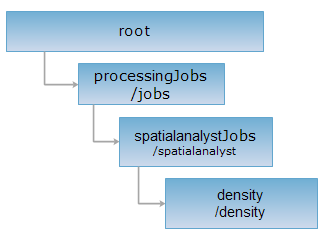
<spatialanalystJobs_uri>/density[.<format>]
The root directory of the density analysis job resource. By sending a GET request to density, you can get the list of the density analysis jobs of the current system. By sending a POST request, you can create a analysis task.
Supported Methods:
Supported output formats:RJSON, JSON, HTML, XML.

Execute HTTP request on the following URI, here we take rjosn as the output format as an example. Where, supermapiserver is the server name.
http://supermapiserver:8090/iserver/services/distributedanalyst/rest/v1/jobs/spatialanalyst/density.rjson
Gets the list of density analysis jobs.
After executing a GET request on the resource, the response entity is a set of density resource descriptions, and the response fields of single resource are as follows:
| Field | Type | Description |
| id | String | Application ID. |
| state | Jobstate | The status of the task. Including execution status, start time, time consuming, and so on. |
| setting | SparkJobSetting | Lists the detailed information of task configuration. |
By executing a GET request on this resource, the returned response result in rjosn format is as follows:
[
{
"id": "546fdbc5_81c3_49a8_8341_1f2fd696da8f",
"setting": {
"DEFAULT_MASTER_ADRESS": "local[*] ",
"analyst": {
"fields": "",
"meshType": "0",
"method": "0",
"query": "",
"radius": "0.01",
"resolution": "0.001"
},
"appName": "density",
"args": [
"--input",
"{\"sliceNum\":20,\"type\":\"udb\",\"info\":[{\"server\":\"F:\\\\20170707\\\\China\\\\China.udb\",\"datasetNames\":[\"China_Capital_pt\"]}]}",
"--radius",
"0.01",
"--method",
"uniform",
"--meshType",
"square",
"--meshSize",
"0.001",
"--output",
"{\"server\":\"F:\\\\20170707\\\\supermap_iserver_win64_zip\\\\webapps\\\\iserver\\\\processingResultData\\\\Analyst\\\\udbs\\\\4ab58165-a839-4c80-b8b2-1a2d98ad465b\",\"datasetName\":\"analystResult\",\"type\":\"udb\"}"
],
"contextSetting": null,
"input": {
"datasetInfo": {
"available": true,
"bounds": "Left=1.2957801616844445E7,Bottom=4852151.575504352,Right=1.2957801616844445E7,Top=4852151.575504352",
"datasetName": "China_Capital_pt",
"datasetType": "POINT",
"epsgCode": 3857,
"name": "China_China_China_Capital_pt",
"readOnly": false,
"type": "UDB",
"url": "F:\\20170707\\China\\China.udb"
},
"datasetName": "China_China_China_Capital_pt",
"numSlices": 0
},
"mainClass": "com.supermap.bsp.main.DensityAnalystMain",
"output": {
"datasetName": "analystResult",
"outputPath": "F:\\20170707\\supermap_iserver_win64_zip\\webapps\\iserver\\processingResultData\\Analyst\\udbs\\4ab58165-a839-4c80-b8b2-1a2d98ad465b"
},
"serviceInfo": {
"targetDataPath": "F:\\20170707\\supermap_iserver_win64_zip\\webapps\\iserver\\processingResultData\\Analyst\\546fdbc5_81c3_49a8_8341_1f2fd696da8f",
"targetServiceInfos": [
{
"path": "http://supermapiserver:8090/iserver/services/distributedanalyst/rest/jobs/spatialanalyst",
"serviceType": "RESTMAP"
},
{
"serviceAddress": "http://supermapiserver:8090/iserver/services/data-kernelDensity8/rest",
"serviceType": "RESTDATA"
}
]
},
"serviceRoot": "http://supermapiserver:8090/iserver/services/"
},
"state": {
"elapsedTime": 6096,
"endState": true,
"endTime": 1499417671510,
"errorMsg": null,
"errorStackTrace": null,
"publisherelapsedTime": 1702,
"runState": "FINISHED",
"startTime": 1499417662453
}
}
]
Creates a kernel density analysis job.
Parameters passed in the request body should contain:
| Name | Type | Description |
| input | FileCSVInputDataSetting DatasetInputDataSetting |
[Required] Supports two input ways: 1. datasetName: dataset name. Used when the data to be analyzed is point dataset provided by the Data Catalog Service, including data imported through Data Catalog Service, registered data in iServer and point datasets stored in DataStore. 2. Input file path and the related information. When the data to be analyzed does not belong to Data Catalog Service, you need use this method. Supported file formats: csv file, udb file, pg database. For detailed parameters' description, see: Big data analysis input parameter settings. |
| analyst | KernelDensityAnalystSetting | [Required] Analysis settings. You need to specify:
|
| output | FileSystemOutputSetting DatabaseOutputSetting |
[Optional] The output of analysis result. Supported output formats: local udb file, database (pg, mongodb). For detailed parameter settings, see: Big data analysis input parameter settings. |
Execute a POST request on density resource to create a point density analysis job: http://supermapiserver:8090/iserver/services/distributedanalyst/rest/v1/jobs/spatialanalyst/density .rjson with the following request body which inputs registered udb file name:
{
"input": {
"datasetName":"China_China_China_Capital_pt"
},
"analyst": {
"query": "",
"resolution": "10"
"radius": "100",
"method": "0",
"meshType": "0",
"fields": "",
"meshSizeUnit": "Meter",
"radiusUnit": "Meter",
"areaUnit": "SquareMeter"
}
}
then the returned resource in rjson format is as follows:
{
"newResourceID": "8bf67620_2c3a_4752_8cce_30076f3fe94e",
"newResourceLocation":"http://supermapiserver:8090/iserver/services/distributedanalyst/rest/v1/jobs/spatialanalyst/density/8bf67620_2c3a_4752_8cce_30076f3fe94e",
"postResultType": "CreateChild",
"succeed": true
}
Execute a POST request on density resource to create a density analysis job: http://supermapiserver:8090/iserver/services/distributedanalyst/rest/v1/jobs/spatialanalyst/density .rjson with the following request body which specifies a local udb file:
{
"input": {
"datasetInfo": {
"type": "UDB",
"url": "F:\\20170707\\China\\China.udb"
"datasetType": "POINT",
"datasetName": "China_Capital_pt",
},
"numSlices": 36
},
"analyst": {
"query": "",
"resolution": "10"
"radius": "100",
"method": "0",
"meshType": "0",
"fields": "",
}
}
then the returned resource in rjson format is as follows:
{
"newResourceID": "015fb79a_0f32_49d1_a0a9_743c10052156",
"newResourceLocation":"http://supermapiserver:8090/iserver/services/distributedanalyst/rest/v1/jobs/spatialanalyst/density/015fb79a_0f32_49d1_a0a9_743c10052156",
"postResultType": "CreateChild",
"succeed": true
}
Execute a POST request on density resource to create a density analysis job: http://supermapiserver:8090/iserver/services/distributedanalyst/rest/v1/jobs/spatialanalyst/density .rjson with the following request body which specifies idata stored in PostgreSQL as the input data:
{
"input": {
"datasetInfo": {
"type": "POINT",
"name": "newyorkPoint_P_1359289148",
"datasourceConnectionInfo": {
"engineType": "POSTGRESQL",
"dataBase": "supermap",
"password": "iserver",
"user": "postgres",
"server": "192.168.120.49"
}
}
},
"analyst": {
"radius": "350",
"method":"0",
"meshType":"0",
"resolution": "50"
"meshSizeUnit": "Meter",
"radiusUnit": "Meter",
"areaUnit":"SquareMile",
"bounds":"-74.050,40.650,-73.850,40.850"
}
}
then the returned resource in rjson format is as follows:
{
"newResourceID": "0c0ef6fd_7efa_4bfe_a652_17fa2ea7e676",
"newResourceLocation": "http://localhost:8090/iserver/services/distributedanalyst/rest/v1/jobs/spatialanalyst/vectorclip/0c0ef6fd_7efa_4bfe_a652_17fa2ea7e676",
"postResultType": "CreateChild",
"succeed": true
}
Returns the same HTTP response header as the GET request, but no response entity, which can be used to retrieve the meta data contained in response message header without having to transmit the entire response content. Meta data information includes media type, character coding, compression coding, entity content length, etc.
HEAD request is used to determine whether the density resource exists, or if the user has the authority to access it. By executing an HEAD request with a .<format> URI, you can quickly determine whether the density resource supports the <format> representation.